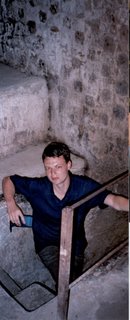Cu Chi Coo

The Cu Chi tunnels, located some fifty kilometres outside Ho Chi Minh City, are a small part of the extensive network of Viet Cong tunnels which stretched at one time from the Cambodian border to the outskirts of HCMC. Sadly, instead of developing the site into a historical snapshot of that terrible era, the Vietnamese authorities have recast the place into something which falls halfway between propaganda camp and theme park.
Visitors to the camp are disgorged from their coaches into a dusty car-park replete with confectionery shops and souvenir sellers. After buying their Cokes and Cornettos everyone is corralled into groups of twenty or so and assigned a tour guide. The first stop is into the classroom for a twenty-minute video which sets the context of the place.
I don't remember the details, but the film portrayed the conflict in a very cut-and-dried, simplistic way. The South Vietnamese were caricatured as American stooges, while the Viet Cong and North Vietnamese as liberators. The actual development of the war was very complex with French colonial aspirations, Buddhist revolts against Roman-Catholic oppression, the Truman Doctrine on the perceived threat of Communism, and the Gulf of Tonkin incident all playing their parts.
A large section of the video went into the physical details of the tunnel systems, with cross-sectional schematics of the hills shown in primary colored graphics. Interesting from an engineering point of view but more political analysis would've been much better, I feel.
The lights came one and we all trooped outside, squinting in the pockets sunlight that came down through the forest canopy above. This wasn't a tropical jungle by any means. Thin withered trees with dry foliage dotted the shallow hill we climbed and the ground was hard and cracked. Perhaps this was an example of the way Vietnam's whole landscape had been transformed by the saturation bombing during the war.
After a couple of minutes we came to the first 'exhibit'. Crowding around our guide who'd stopped in the middle of the path, we watched him kick away some dirt on the ground and reveal a small wooden trapdoor about the size of a piece of A4 paper. He popped a finger into a gap in the wood and pulled the door away.
It was an entrance to the tunnel system.
We were all invited to take turns standing in the hole for a photo-op. It was a weird feeling posing for a picture while at the same time experiencing the claustrophobia of the tight walls. To get your arms in you had to put your hands above your head like readying yourself for a dive and then crouch down and pull them in. Fortunately the tunnel leading off the entrance was blocked off so it wasn't even possible to get underground.
Throughout the area were mock-ups of makeshift bomb factories, kitchens and living spaces--dug into the ground rather than actually under it like in the original rooms. The lifeless models of the Viet Cong, the hordes of tourists, and the daylight all undermined the power of these mock-ups though. No sense of the fear or the determination or the confinement that these people must've felt came through in these delicate reconstructions.
Later we did get a chance to get into the tunnel system proper, however. The passages had been considerably widened from their original size and lamps lined the sides, but it still managed to give a tiny flavour of the conditions. How people managed to live in these warren-like tunnels is astounding.
The tour finished with a shooting range where trigger-happy tourists could fire off a few rounds of Russian, Chinese and French firearms. Very surreal, and for me, the thought of pretending to be Rambo made me feel queasy so I didn't do it. That didn't stop quite a few of my group picking up a Kalashnikov and letting rip, though. What is it with men and guns?
So overall: interesting as a sociological insight into how the Vietnamese presented the history of the war and what tourists want; disappointing for learning the subtle complexities of the war and the stories of real participants; depressing in the way many visitors approach the place.
In the evening, back in HCMC, I took a long walk around the city. The New Year celebrations go on for four days so there's still a holiday feel in the air, but I wandered around in an aimless fashion feeling detached from the events. Two boys were working in a team were trying to pickpocket unwary tourists near a street food-stall. Even after I'd clocked what was going on they still kept circling me, and it became farcical as I tried to explain I knew what they were up too and I wasn't going to let them steal from me.
Being able to travel is a real luxury. Every day when I wake-up there is a moment of realisation that I'm half-way round the world, thousands of miles from friends and family, and have no real idea how the day will map out. It's scary. But then I remember the feeling I got when I used to wake-up on a weekday and know I had to go into an office. That's when I feel very privileged. My challenge is to turn that fear into excitement; to stop observing so much and begin participating more; to find things in life that make me jump out of bed in the morning rather than groan. I can feel these changes coming, but they're slow and come with a lot of frustration.
I got back at nine thirty to find the guest-house staff asleep in the communal area on the ground floor. They don't get any personal space whatsoever. It's almost unimaginable to a person from a developed country. It's a bit of head-fuck to think that it may not bother them in the slightest and a bigger one to think it may not even cross their minds. What will people in fifty or a hundred years think about the way we live today?
I went upstairs and started reading a book called 'A Bright Shining Lie' which is about one American soldier's experience of the war. Here, in 2006, as I write this, I have to admit I barely remember one line from that book. It makes we wonder if I should've been making more opportunity of where I was.



1 Comments:
I liked the pics a lot, the second revealing how the feel of the place touched you, and how the fears are going to turn into excitement about participating more in those new worlds.
In the first one, the playfulness of the shadows on the mural make the painting and the content more alive, more faded and harshly real at the same time. It makes me watch it more carefully. With the branch reaching towards the painting, nature is more drawn into it. Great! :) Actually, this is what i was experimenting with (shadows/shades) in my drawing. I'm still postponing the attempt to represent shades in an acquarell pencil. Soon, soon...
Reading novels, history books, etc before visiting a place is so essential, makes me think how much earlier you've got to start preparing your mind for a journey. In Italy I felt that I knew less than the basic info about the country and regions, which still allowed me to neutrally get the feel of the place, but i also felt that i was missing out on some points.
About the tunnels: scary!!! but definitely would visit them, hopefully without an average tourist's air!
Post a Comment
<< Home